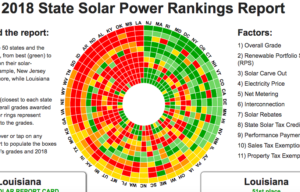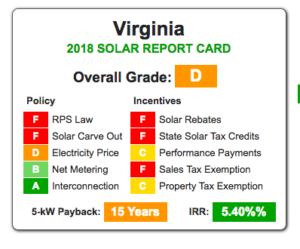Former Governor Terry McAuliffe exclaimed, more than once, that Virginia was a true leader in solar power, with growth rates that should amaze one and all. While McAuliffe deserves credit for a number of actions, recognizing the reality of a GOP run legislature and heavy Dominion Power opposition to solar, reality didn’t seem to match the rhetoric.
Pulling back the curtains on Virginia solar left one scratching one’s head trying to figure out the justification for this. Yes, there was growth — primarily because of two things: the starting point (due in no small part to Dominion Virginia Power (primarily) working its magic in the legislature to suppress solar) was so low; and major players (such as Amazon data centers and universities) demanding solar (often, as with Amazon, as part of their choice to develop in Virginia). McAuliffe pointed to high percentage growth and then pointed to all the potential projects in the pipeline with wording that would make most casual observers think that those ‘maybe’ projects were done deals and, well, perhaps even already generating electrons. Show-barker exclamations, however, didn’t represent the reality of Virginia’s renewable energy world.
As Powered by Facts, a group heavily involved in supporting legislative movement toward a clean(er) Virginia energy future, explained in a January 2018 report.
Virginia now has 290.89 megawatts (MW) of solar installed, which represents approximately .037% of its total electricity generated. This is an increase from last year’s total of 192.4 MW, and represents the state moving more than half of the way towards Dominion’s goal of building facilities to generate 400 MW of solar energy by 2020. Despite the increase in MW, Virginia’s national ranking for solar and renewable energy slipped from 17th in 2016 to 20th in 2017. This indicates that other states have embraced this highly competitive industry and are reaping its rewards, while Virginia has lagged behind. Our state also ranks 13th in growth projections for the next five years
While ’20th’ rank of current status with 13th in growth might not seem so bad, putting Virginia in the upper half of the 51 states and DC, we shouldn’t be fooled into any form of complacency.
Each year Solar Power Rocks, a firm that focuses on helping homeowners and small businesses go solar, analyzes those 51 as to solar attractiveness for those potential customers.

In the 2018 ranking, as in 2017, Virginia is ranked 38th and earns a merited D.

“Solar in Virginia: about as bad as you might think!” The state’s big utility company, Dominion Power, offers an anemic performance payments program, which will help homeowners now but isn’t guaranteed to be there in a few years. All in all, the “D” grade is earned …

With the exception of relatively smooth connection into the grid and straightforward net metering rules, this report card doesn’t have much good news as to Virginia solar as ‘the’ system continues to favor polluting centralized energy over distributed, clean-energy.
The troubling (for many reasons) energy legislation that has passed (in two variations) the Virginia House and Senate offers a potential breakthrough when it comes to solar. Within the legislation is a declaration that 4,000 megawatts of utility-scale and 500 megawatts of distributed solar (though, owned/operated by utility …) is in the public interest. While this is overly weighted toward large systems (roughly, in the United States, 1/3rd of total solar deployment is in under 1 megawatt systems), overwhelming favorable to the utilities, and the devil will certainly be in the details, this is viewed as creating an agreed-upon based objective that would increase Virginia’s solar electric resources by more than an order of magnitude in less than a decade. If the legislative and regulatory changes are made to enable this to become reality, perhaps Virginia’s report card might be a bit better and Terry McAuliffe’s claims about Virginia solar might just become substantive reality.
NOTE: Originally posted at Get Energy Smart, NOW! Additional discussion of the Solar Power Rocks’ report there.



 Sign up for the Blue Virginia weekly newsletter
Sign up for the Blue Virginia weekly newsletter![Video: UVA Prof. Larry Sabato Says We “Need to Take [Trump] Seriously” Regarding His Threat to Seek a Third Term](https://bluevirginia.us/wp-content/uploads/2025/03/sabatocnn1-238x178.jpg)






![Video: UVA Prof. Larry Sabato Says We “Need to Take [Trump] Seriously” Regarding His Threat to Seek a Third Term](https://bluevirginia.us/wp-content/uploads/2025/03/sabatocnn1-100x75.jpg)

